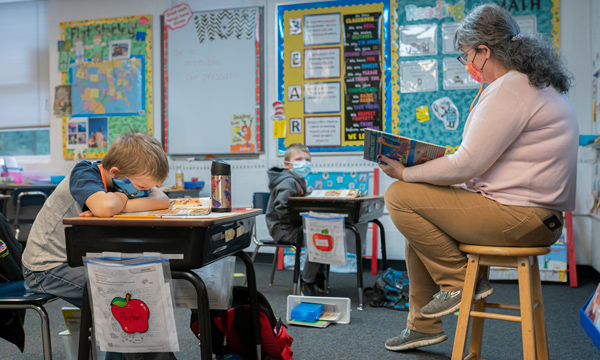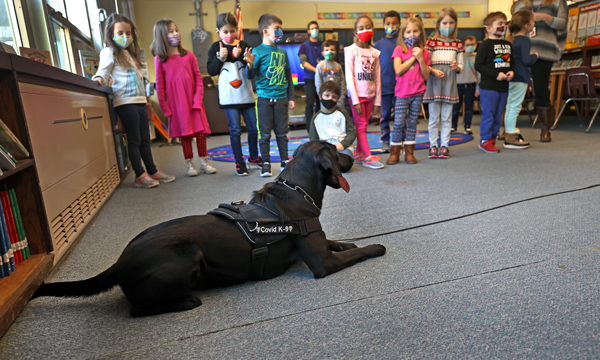COVID Brief: New Data Capture Pandemic’s Toll on Student Attendance, Grades, Advancement
A weekly roundup of headlines about how the pandemic is shaping schools and education policy, vetted by AEI Visiting Fellow John Bailey

Get stories like this delivered straight to your inbox. Sign up for The 74 Newsletter
This is our biweekly briefing on the pandemic, vetted by John Bailey. See the full archive.
This Week’s Top Story
- EdWorking Paper: “This study extends research evidence to additional student outcomes — absences, course grades and grade retention — and to examine how pandemic effects are distributed across students.”
- “Using a combination of descriptive and regression analyses, we find negative average impacts on all outcomes.”
- “Effects are also largest in middle school for most outcomes and are typically larger among historically marginalized groups of students.”

Top Three
Dogs Were Highly Accurate in Detecting COVID-19 in Schools
- “Scent-trained dogs detected COVID-19 infection with 83% sensitivity and 90% specificity in nearly 3,900 screenings at California K-12 schools in spring 2022, according to a research letter published today in JAMA Pediatrics.” More via CNN.
- ” ‘While modifications are needed before widespread implementation, this study supports use of dogs for efficient and noninvasive COVID-19 screening and could be used for other pathogens,’ [researchers] concluded.”

New Data Show Safety of Pfizer COVID Vaccine for Teens
- Via CIDRAP: “[Last week] in Pediatrics researchers published the safety data of the Pfizer-BioNTech (BNT-162b2) COVID-19 vaccine in adolescents ages 12 to 17 years. After one year, very few serious adverse events were reported, and instances of myocarditis (inflammation of heart muscle) were lower than initially reported.”
- “The authors conclude that the vaccine is safe for this age group, noting that the risk of cardiac disease after COVID-19 infection may be two- to sixfold higher than after vaccination.”
A Playbook to Address Students’ Mental Health Needs
- Via EdWeek: “AASA, The School Superintendents Association, and The Jed Foundation this week announced the initiative, called The District Comprehensive Approach, that aims to provide school districts across the country with a framework of best practices, expert support and data-driven guidance about how to best support students’ mental health and prevent suicide.”
- “The organization’s guidance for high schools focuses on seven overarching themes: developing life skills, promoting social connectedness, encouraging help-seeking behaviors, improving recognition of signs of distress, access to mental health care, establishing crisis management procedures and promoting the importance of keeping lethal and dangerous items away from children.”
- Related: Despite ‘crisis,’ states and districts slow to spend $1B in mental health funds
Federal Updates
White House: Susan Rice, director of the White House Domestic Policy Council, is stepping down. A potential replacement could be senior adviser Neera Tanden.
Education Department: Supporting Schools’ Use of Evidence to Guide Ed Tech Adoption.
Institute of Education Sciences: What’s on tap at IES for the next year? Director Mark Schneider shares his priorities.
Centers for Disease Control and Prevention: CDC simplifies COVID-19 vaccine recommendations. Katelyn Jetelina explains.
City & State News
California: Districts see more chronic absenteeism than before pandemic.
Michigan: Detroit Public Schools Community District is eyeing staffing cuts as COVID funding comes to an end.
New York: “Enrollment in New York City’s public schools, the country’s largest school district, dropped by 8.3% from 2020 to 2022, according to a fiscal watchdog funded by the city.”
North Carolina: “A new analysis of North Carolina test results from the 2021-22 school year shows that students made significant strides from the previous year in recovering instructional time lost to the COVID-19 pandemic.”
Ohio: Most families qualify for $1,000 to pay for camps, tutoring.
COVID-19 Research
In-Person School Reopenings Tied to Modest Rise in Community COVID Spread
- “A study of U.S. counties suggests that communities with schools that switched from remote to in-person instruction in fall 2020 had slightly higher COVID-19 case rates four to eight weeks later than those that remained virtual.”
- “The magnitude of school contribution to community transmission found in this study must be interpreted in the context of the potential benefits of in-person instruction models on the academic, social, mental health and physical outcomes of many students.”
- “The implications for future public health preparedness include consideration of the relatively small and manageable magnitude of school contribution to community transmission that may present a tolerable risk for the resumption of in-person education, with sufficient mitigation measures.”
WHO Issues Initial Omicron XBB.1.16 Risk Assessment
- “Based on the assessment, the [World Health Organization] on April 20 said it elevated XBB.1.16 from a variant under monitoring to a variant of interest.”
- “So far, no changes in severity have been reported. XBB.1.16 doesn’t seem to come with additional health risks compared to XBB.1.5, but it may become dominant in some countries owing to its growth advantage and immune escape properties.”
In-Depth
Student Access to Teletherapy Skyrockets
- Via Chalkbeat: “Thirteen of the nation’s 20 largest districts have added teletherapy since the pandemic began.”
- “ ‘It’s not for everybody, but for those students and parents who want that, it’s been fantastic,’ said JaMaiia Bond, who oversees student mental health services for Compton’s schools in California, which started offering teletherapy through Hazel Health this school year.”
‘Kids Can’t Read’: The Revolt Taking On the Education Establishment
- Via The New York Times: “The movement, under the banner of ‘the science of reading,’ is targeting the education establishment: school districts, literacy gurus, publishers and colleges of education, which critics say have failed to embrace the cognitive science of how children learn to read.”
- “Ohio, California and Georgia are the latest states to push for reform, adding to almost 20 states that have made moves in the last two years. Under pressure, school districts are scrapping their old reading programs.”
Bill Gates Talks Learning Recovery, AI and His Big Bet on Math
- Via The 74: “There is a gigantic upside in improving our public education system, both economically and in terms of equity,” Gates said. “But the country’s not falling apart as much as you might think.”
- “The shortcomings of the U.S. education system are clear in terms of the inequity you end up with: the kind of jobs, salaries, mobility you’d like to see in society. Education is the great enabler of mobility, and we’re falling short on that.”
- “I think the predictions that this is going to hurt us in the long run are true, and we’d be further ahead if we were running our education system as well as we’d like to.”
…And on a Lighter Note
⚾ She Literally Did a Cartwheel: On the way to first base.
For even more COVID policy and education news, subscribe to John Bailey’s briefing via Substack.
Disclosure: John Bailey is an adviser to the Walton Family Foundation, which provides financial support to The 74.
Get stories like these delivered straight to your inbox. Sign up for The 74 Newsletter

;)
